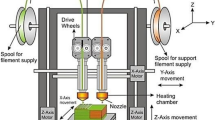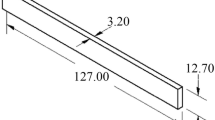Abstract
Fused filament fabrication (FFF) has been used to manufacturing customizable products, which offers tremendous advantages due to its ability to create end-use products having any complex geometry in shorter lead-time. However, the application of the FFF process in functional parts is restricted due to the poor mechanical performance because of the nature of the process to form the object in a layer-by-layer manner. The mechanical properties of the FFF-printed object are largely influenced by the selection of the build parameters. Hence, in this study, the impact strength of the FFF fabricated PLA has been evaluated as a function of three build variables viz. raster angle, layer height, and raster width. The impact test specimen was fabricated at varying build conditions and tested as per the ASTM D256 standard. Results showed that the raster angle was found to be the most significant build parameter that affects the impact strength of a printed specimen. The higher impact strength was achieved at 0° raster angle with 300 µm layer height and 700 µm raster width. However, the results obtained may be effective only within the limit of parameters and ranges tested in this work. Furthermore, SEM analysis of fracture surface reveals that failure mode is influenced mainly by the raster angle. Apart from that, voids have also been displayed on the fractured surface that may act as stress concentration and reduce the strength.











Similar content being viewed by others

Availability of data and materials
Not applicable.
References
Bamiduro O, Owolabi G, Haile MA, Riddick JC (2019) The influence of load direction, microstructure, raster orientation on the quasi-static response of fused deposition modeling ABS. Rapid Prototyp J 25:462–472. https://doi.org/10.1108/RPJ-04-2018-0087
McLouth TD, Severino JV, Adams PM, Patel DN, Zaldivar RJ (2017) The impact of print orientation and raster pattern on fracture toughness in additively manufactured ABS. Addit Manuf 18:103–109. https://doi.org/10.1016/j.addma.2017.09.003
Costa AE, da Silva AF, Carneiro OS (2019) A study on extruded filament bonding in fused filament fabrication. Rapid Prototyp J 25(3):555–565. https://doi.org/10.1108/RPJ-03-2018-0062
Peng F, Zhao Z, Xia X, Cakmak M, Vogt BD (2018) Enhanced impact resistance of three-dimensional-printed parts with structured filaments. ACS Appl Mater Interfaces 10(18):16087–16094. https://doi.org/10.1021/acsami.8b00866
Dawoud M, Taha I, Ebeid SJ (2016) Mechanical behaviour of ABS: An experimental study using FDM and injection moulding techniques. J Manuf Process 21:39–45. https://doi.org/10.1016/j.jmapro.2015.11.002
Wang L, Gardner DJ (2017) Effect of fused layer modeling (FLM) processing parameters on impact strength of cellular polypropylene. Polym 113:74–80. https://doi.org/10.1016/j.polymer.2017.02.055
Wang L, Gramlich WM, Gardner DJ (2017) Improving the impact strength of Poly (lactic acid) (PLA) in fused layer modeling (FLM). Polym 114:242–248. https://doi.org/10.1016/j.polymer.2017.03.011
Upadhyay K, Dwivedi R, Singh AK (2017) Determination and comparison of the anisotropic strengths of fused deposition modeling P400 ABS. In: Wimpenny D, Pandey P, Kumar L (eds) Advances in 3D Printing & Additive Manufacturing Technologies. Springer, Singapore, pp 9–28
Kamoona SN, Masood SH, Mohamed OA (2017) An investigation on impact resistance of FDM processed Nylon-12 parts using response surface methodology. AIP Conf Proc 1859(1):020120
Górski FI, Kuczko WI, Wichniarek RA (2014) Impact strength of ABS parts manufactured using Fused Deposition Modeling technology. Arch Mech Technol Autom 31(1):3–12
Es-Said OS, Foyos J, Noorani R, Mendelson M, Marloth R, Pregger BA (2000) Effect of layer orientation on mechanical properties of rapid prototyped samples. Mater Manuf Process 15(1):107–122. https://doi.org/10.1080/10426910008912976
Ziemian C, Sharma M, Ziemian S (2012) Anisotropic mechanical properties of ABS parts fabricated by fused deposition modelling. In: Gokcek M (ed) Mechanical engineering. United Kingdom; InTech Open, pp.159–180.
Tsouknidas A, Pantazopoulos M, Katsoulis I, Fasnakis D, Maropoulos S, Michailidis N (2016) Impact absorption capacity of 3D-printed components fabricated by fused deposition modelling. Mater Design 102:41–44. https://doi.org/10.1016/j.matdes.2016.03.154
Fatimatuzahraa AW, Farahaina B, Yusoff WA. (2011) The effect of employing different raster orientations on the mechanical properties and microstructure of Fused Deposition Modeling parts. In: 2011 IEEE Symposium on Business, Engineering and Industrial Applications (ISBEIA) pp. 22–27.
Roberson DA, Perez AR, Shemelya CM, Rivera A, MacDonald E, Wicker RB (2015) Comparison of stress concentrator fabrication for 3D printed polymeric izod impact test specimens. Addit Manuf 7:1–11. https://doi.org/10.1016/j.addma.2015.05.002
Gurrala PK, Regalla SP (2014) Part strength evolution with bonding between filaments in fused deposition modelling. Virtual Phys Prototyp 9(3):141–149. https://doi.org/10.1080/17452759.2014.913400
Sood AK, Ohdar RK, Mahapatra SS (2010) Parametric appraisal of mechanical property of fused deposition modelling processed parts. Mater Design 31(1):287–295. https://doi.org/10.1016/j.matdes.2009.06.016
Pivsa-Art W, Chaiyasat A, Pivsa-Art S, Yamane H, Ohara H (2013) Preparation of polymer blends between poly (lactic acid) and poly (butylene adipate-co-terephthalate) and biodegradable polymers as compatibilizers. Energy Procedia 34:549–554. https://doi.org/10.1016/j.egypro.2013.06.784
Jo MY, Ryu YJ, Ko JH, Yoon JS (2012) Effects of compatibilizers on the mechanical properties of ABS/PLA composites. J Appl Polym Sci 125:231–238. https://doi.org/10.1002/app.36732
Tsuji H (2014) Poly (lactic acid). In: Kabasci S (ed) Bio-based plastics: materials and applications. Willey, United Kingdom, pp 171–239
Choe IJ, Lee JH, Yu JH, Yoon JS (2014) Mechanical properties of acrylonitrile–butadiene–styrene copolymer/poly (l-lactic acid) blends and their composites. J Appl Polym Sci. 131:40329. https://doi.org/10.1002/app.40329
ISO/ASTM 52921, 2013. Standard terminology for additive manufacturing–coordinate systems and test methodologies.
Internasional, ASTM, 2018. ASTM D256–10 Standard Test Methods for Determining the Izod Pendulum Impact Resistance of Plastics.
Coogan TJ, Kazmer DO (2017) Bond and part strength in fused deposition modeling. Rapid Prototyp J 23:414–422. https://doi.org/10.1108/RPJ-03-2016-0050
Funding
Not applicable.
Author information
Authors and Affiliations
Corresponding author
Ethics declarations
Conflict of interest
The authors declare that they have no conflict of interest.
Additional information
Publisher's Note
Springer Nature remains neutral with regard to jurisdictional claims in published maps and institutional affiliations.
Rights and permissions
About this article
Cite this article
Rajpurohit, S.R., Dave, H.K. Impact strength of 3D printed PLA using open source FFF-based 3D printer. Prog Addit Manuf 6, 119–131 (2021). https://doi.org/10.1007/s40964-020-00150-6
Received:
Accepted:
Published:
Issue Date:
DOI: https://doi.org/10.1007/s40964-020-00150-6



